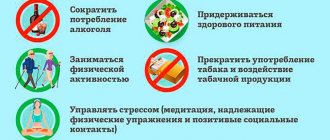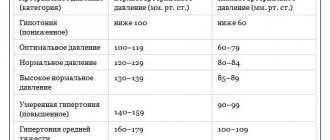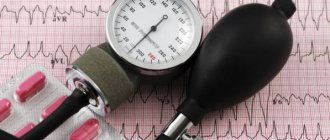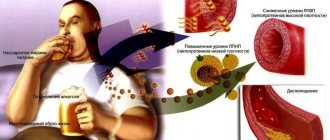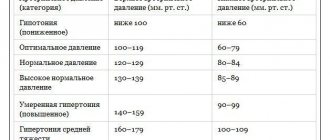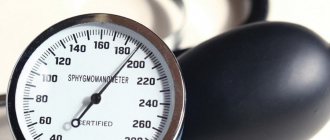Norm or pathology
Blood pressure 130 over 60 - what does this mean? Any specialist who deals with diseases of the cardiovascular system can answer this question. These values differ from the standard blood pressure indicators of 120 to 80. Therefore, they cannot be considered the norm.
If these indicators were obtained when measuring blood pressure, then a person risks one day encountering the following diseases:
- Stroke;
- Hypotension;
- Heart attack;
- Heart failure;
- Impaired brain activity;
- Alzheimer's disease.
This value indicates decreased diastolic and increased systolic pressure. If this condition is accompanied by unpleasant symptoms, the patient should visit a cardiologist.
Causes
Blood pressure, which is characterized by values of 130 to 60, can appear for various reasons. Most often, the following violations are involved:
- Thyrotoxicosis;
- Poisoning;
- Allergy;
- Thyroid dysfunction;
- Problems with the adrenal glands;
- Heart attack;
- State of shock;
- Vegetovascular dystonia;
- Heart disease;
- Blood loss;
- Kidney diseases;
- Malignant tumors.
A pressure of 130 over 60 can occur with thyroid pathologies
Such pressure is not always a sign of illness. In some cases, it occurs due to the individual characteristics of the human body or performing intense physical exercise.
Symptoms
Often, with a blood pressure of 130 over 60, people feel unwell. It may be accompanied by a number of symptoms:
- Chills;
- Nausea;
- Neurosis;
- Feeling of pressure in the heart area;
- Weakness;
- Lack of air;
- Anxiety;
- Dizziness;
- Migraine;
- Sweating.
The person will be irritated and depressed. With this disorder, sudden changes in mood may also occur.
Headache
Due to impaired blood pressure, patients often have headaches. This is one of the symptoms of a malfunction of the cardiovascular system. The painful phenomenon is characteristic of an increased systolic reading. If headaches occur regularly and are accompanied by dizziness and nausea, a person should make an appointment with a doctor to find out the cause of the ailment.
Headache is a common sign of blood pressure problems
Blood pressure 130 over 50 - is it dangerous for a person, a teenager and what to do?
A blood pressure of 130 over 50 is abnormal.
There are cases when, with these indicators, there are no symptoms, but nevertheless it is still a pathology for both young and elderly people.
If you do not seek the help of specialists with such blood pressure, you can get a number of serious diseases, including dangerous heart and vascular diseases.
What does pressure 130 over 50 mean?
If we talk about the upper (systolic) indicator, then for many people it is normal. Diastolic pressure 50 mm Hg. st is considered very low for an adult and this means that there is a fairly serious pathology in the body. In adolescents, these indicators are also low.
If the lower pressure drops to 40, you must call an ambulance
In addition, there is a very large “run” between the lower and upper pressure, which can subsequently lead to diastolic hypertension and a number of other quite dangerous diseases. With such blood pressure levels, it would be advisable to consult a cardiologist as soon as possible, who will help identify the cause of this disease and prescribe timely treatment.
Causes
There are many reasons that cause a decrease in diastolic pressure.
There are pathological (right) and non-pathological (left) causes of low blood pressure
Most often, blood pressure levels decrease due to:
- Previous myocardial infarction;
- Atherosclerosis;
- Abuse of bad habits;
- Congenital or acquired kidney pathologies;
- Heart defect;
- Excessive physical activity;
- Anemia and heavy bleeding;
- Diseases of the endocrine system;
- Use of certain medications;
- Frequent stress, nervous breakdowns;
- Stenosis (narrowing) of blood vessels;
- Tumors of various origins;
- Severe intoxication after poisoning with any toxic substances.
Note. Often such pressure occurs during the rehabilitation period after surgical interventions. In addition, this pathology can occur in people who react to weather phenomena, for example, a sharp change in atmospheric pressure.
Symptoms
The disease rarely occurs without symptoms. As a rule, with blood pressure readings of 130 over 50, the following phenomena are observed:
- Nausea, often vomiting;
- Pulse jumps - possible both up and down;
- General weakness, apathy;
- Frequent dizziness;
- Regular increased heart rate;
- Excessive sweating;
- Often there is a feeling of panic and anxiety;
- The most common symptom is severe throbbing or pressing headaches;
- Breathing disorders (lack of air);
- Sudden mood swings;
- Most patients experience a feeling of chest tightness;
- Malfunctions of the gastrointestinal tract;
- Hands and feet get cold, and fainting often occurs.
Low blood pressure can lead to fainting
If, with this disease, the pulse pressure becomes over 80-90 beats per minute, then, most likely, the cause of this pathology is a disruption of the endocrine system. This is explained by the fact that when diastolic pressure decreases, the thyroid gland works in an enhanced mode. This is what can cause an increased heart rate.
Consequences
The pathology is life-threatening and if you do not consult a doctor in time, there is a possible risk of developing:
- Acute heart failure;
- Stroke, as well as myocardial infarction;
- Alzheimer's disease (disease of the central nervous system). Basically, the disease develops in an elderly person (over 60 years old);
- Due to constant fatigue, absent-mindedness and emotional distress, the patient’s quality of life is significantly reduced;
- Due to the fact that with this disease blood circulation is impaired, blood stagnation is possible.
Important! During pregnancy, blood pressure 130 over 50 is dangerous for the child, as there is a risk of developing fetal hypoxia.
To prevent the occurrence of the disease and improve a person’s quality of life, experts recommend adhering to a number of preventive measures:
- First, you need to completely eliminate bad habits (in particular, alcohol and smoking);
- An important factor in treatment and prevention is nutrition. First of all, you need to exclude unhealthy foods (fried, smoked, hot, spicy, fatty, overly salty). The maximum daily salt intake is 5 grams. It is better to eat foods rich in vitamins (fruits, vegetables, fresh herbs);
- It is also necessary to avoid stressful situations, excessive physical and emotional stress;
- It is important to follow your daily routine. Regardless of what type of activity a person has, it is imperative to find time to relax;
- If there is a risk of problems with blood pressure, regular monitoring of indicators is necessary. In case of a decrease or increase in blood pressure, it is better not to progress the disease and contact a specialist in a timely manner;
- In order to strengthen the cardiovascular system and the entire body as a whole, it is necessary to play sports;
- If your doctor has prescribed medications for high or low blood pressure, you should not stop taking the medications on your own or exceed the dosage.
Preventative measures to prevent high blood pressure
Treatment
What to do if your blood pressure is 130 to 50 mm Hg. Art? After diagnosis, the specialist prescribes medications depending on the cause that caused the disease, as well as based on the symptoms. For these purposes, medications may be prescribed:
- For the treatment of diseases of the cardiovascular system;
- Improving blood circulation;
- Vitamin complexes;
- To relieve symptoms (headaches, vomiting, gastrointestinal problems, etc.).
In case of illness, it is important to remember that uncontrolled use of medications, especially for high or high blood pressure, is unacceptable.
Any medicine has serious contraindications, and if used incorrectly, it can significantly worsen the patient’s condition.
When providing first aid, it is better to put the person in bed (half-sitting position) and immediately call an ambulance.
Source: https://gipertonia.guru/normy-davleniya/davlenie-130-na-50/
Specific heart rate value
When measuring blood pressure, you need to pay attention to your pulse. If it is rapid, then this does not always indicate pathology. This phenomenon can be observed due to recent physical activity or emotional experience.
In a healthy person, the heart rate should be 60-80 heartbeats per minute. Rapid pulsation often indicates problems in the thyroid gland, which can cause surges in blood pressure.
If, at a pressure of 130 over 60, a pulse of 90 beats per minute is observed, then doctors define it as elevated. This condition is considered unhealthy unless it is caused by anxiety or intense physical activity.
What pressure is considered normal?
In a healthy person, the systolic reading should not exceed 130 mmHg, and diastole should not exceed 90 mmHg. Normal pulse is from 70 to 85 depending on age: the older the patient, the higher the pulse. If a patient has constantly elevated levels, this indicates the presence of arterial hypertension (hypertension); at an early stage, the disease can be eliminated with proper treatment and undergoing various procedures. Low lower pressure is not normal, so it must be determined and the cause found.
Under the influence of various factors, indicators change throughout the day. For example, at rest the numbers may drop to normal; after vigorous exercise, the heart pumps more blood and they increase. The measurement process is carried out strictly at rest. Even the time of day can affect the value. Most measurements are taken in the middle of the day.
Treatment
As soon as it is clarified what a blood pressure reading of 130 over 60 means, you can begin to treat the painful condition. Doctors do not recommend immediately taking medications to normalize blood pressure in case of such a disorder. This is especially true for young people. To eliminate this unpleasant problem, you just need to follow these recommendations:
- Make time for regular exercise;
- Reconsider your lifestyle;
- Allocate enough time for rest and work;
- To refuse from bad habits;
- Provide yourself with adequate nutrition.
If these measures were not enough, and the problem with pressure in the arteries remains relevant, a full examination in the hospital will be required.
In many cases, it is possible to normalize blood pressure simply by adjusting your lifestyle.
Features of treatment
The main rule is treatment of the underlying disease, since in most cases the pathology is latent and even when symptoms appear does not require emergency help (but always becomes a reason for medical consultation!). In the treatment of diseases that provoke the anomaly, an individual drug regimen is used, if one has already been developed by a doctor. In this case the following is used:
- diuretics: Diacarb, Lasix, Spironolactone;
- beta blockers: Concor, Betalok, Propanol (they are indicated for tachycardia);
- calcium channel blockers: Norvasc, Farmadipine, Amlodipine;
- potassium and magnesium preparations: Panangin, Asparkam, Aspangin;
In all other cases, with blood pressure 130/60 (130/50 or 70), you need to consult a doctor in order to prescribe adequate therapy. Heart defects may require surgery.
Different people
All people react differently to non-standard pressure, at which indicators of 130 over 60 are observed. Some begin to have a headache and nausea. Others do not feel signs of malaise and are not even aware of the existing disturbance in the functioning of blood vessels.
During pregnancy
For a pregnant woman, a blood pressure of 130 over 60 is quite normal. This deviation is considered as a pathology only if the remaining parameters are within acceptable limits.
More dangerous during pregnancy is pressure with values of 130 to 50. It indicates poor blood supply to the fetus, lack of nutrients and oxygen starvation. If the bottom number is 60, then doctors can diagnose hypotension.
In older people
In an elderly person, pressure with values of 130 over 50 is considered quite adequate. It is caused by age-related changes in the body. If there are no signs of illness, then there is no reason to worry. If an elderly person has symptoms such as dizziness, darkening of the eyes, tinnitus and severe weakness, then he definitely needs to see a specialist.
What to do
A blood pressure of 130/70 mm Hg can be the limit of normal or mean a pathological process in the body. If these tonometer numbers are working, you don’t need to do anything.
If the systolic parameter has increased slightly due to stress, anxiety, or overwork, then the person should rest, drink a light sedative (motherwort tincture, a couple of valerian tablets, lemon balm decoction or hawthorn tea).
For headaches, you can take a painkiller (for example, Tempalgin, No-shpu or Valium). When pressure 130 over 70 is a sign of pathology, it is necessary to begin treatment of the main disease.
To make an accurate diagnosis, you need to undergo an examination. Doctors usually refer the patient for urine and blood tests, an ultrasound of the abdominal cavity and heart, and an ECG.
Enalapril tablets
The initial stage of hypertension can be easily overcome by reviewing and adjusting your daily diet and giving up bad habits. If such actions do not produce results, the systolic parameter continues to increase, then doctors prescribe antihypertensive drugs.
For example, Lozap, Enalapril, Veroshpiron, Hypothiazide, Raunatin help reduce the upper blood pressure parameter. Drugs from the group of beta-blockers are not used due to the fact that they can lower the already low diastolic reading.
In parallel with drug treatment, therapists advise:
- normalize weight (if you are overweight);
- reduce the amount of salt and sugar in the diet;
- eat balanced and regularly;
- increase physical activity (start doing exercises in the morning, sign up for fitness or a gym, organize evening walks);
- drink vitamin and mineral complexes;
- reduce consumption of spicy, fatty, fried foods;
- stop smoking and give up alcoholic beverages;
- normalize sleep;
- stop taking caffeine-containing products, chocolate, or consume them in small quantities and in the morning;
- be less nervous;
- do not overexert yourself physically;
- ventilate the apartment regularly;
- undergo medical preventive examination on time.
To determine the effectiveness of measures to reduce systolic and increase diastolic blood pressure, it is necessary to regularly measure it using.
Features of specific pressure values
People prone to hypertension react sharply to changes in blood pressure. Especially when there is a big difference between the upper and lower values.
Blood pressure 130 over 60
In this case, diastolic pressure is suspicious. Under no circumstances should you try to lower it, as this may cause the systolic value to drop. Sometimes blood pressure 60 is a sign of normality. This applies to men and women who are actively involved in sports or are exposed to emotional shock.
These blood pressure readings are considered normal for athletes.
Blood pressure 130 over 50
A blood pressure of 130 over 50 may indicate serious problems in the functioning of blood vessels and the heart. It indicates the development of a pathological process even in the absence of painful symptoms. Blood pressure with such values is especially dangerous for older men and women, as it can lead to stagnation in the blood. Against this background, the likelihood of stroke and myocardial infarction increases.
Blood pressure 130 over 58
- 1 Measurement rules
- 2 Normal or pathological?
- 3 Reasons for pressure 130/60
- 4 Symptoms
- 5 130/60 during pregnancy
- 6 What does it mean and what to do?
Have you been trying to cure HYPERTENSION for many years?
Head of the Institute of Treatment: “You will be amazed at how easy it is to cure hypertension by taking it every day...
Read more "
Arterial indicators are individual. They depend on many factors and the state of the human body at a particular moment. Pressure 130 to 60 mmHg. Art.
sometimes it is a variant of the norm, and sometimes it indicates the presence of a pathological process in the body. It’s worth taking a closer look at your well-being. If such indicators cause discomfort, you need to seek professional help.
If not, monitor your condition and periodically monitor your blood pressure.
Measurement Rules
Blood pressure is measured both in medical institutions and at home. A tonometer is used for this. This device comes in 2 types:
on
- mechanical;
- electric.
To get accurate results, you should avoid taking medications a few hours before starting the measurement. 30-45 minutes before the procedure you should:
- eliminate physical and emotional stress;
- do not drink, do not eat, do not smoke;
- empty your bladder.
During measurement, you must adhere to certain rules:
- sit down;
- take a comfortable position;
- attach the device to the forearm;
- place your hand at chest level;
- relax;
- don't worry;
- don't talk;
- do not move.
Blood pressure should always be measured on both arms for reliable results.
Any device sometimes makes mistakes, so if the results turn out to be far from generally accepted norms, do not worry. To confirm or refute the data obtained, you need to carry out the procedure on the other hand.
After 20-30 minutes, you can repeat the manipulation on both hands. To ensure the reliability of the results and track the dynamics, you should measure your blood pressure twice a day for a week, in the morning and evening.
Normal or pathological?
Blood pressure is determined by the following parameters:
- systolic (maximum, upper), indicating the work of blood vessels and the heart;
- diastolic (minimum, lower), informing about the condition of the kidneys and adrenal glands;
- pulse, showing the difference between the maximum and minimum values.
The optimal pressure is 120 to 80 mmHg. Art. with minor deviations. Variants of the norm are considered to be 130 to 85 mmHg. Art., it is considered as normal elevated, or 110 per 70 mm Hg. Art. - normal low.
Moreover, such indicators should not be accompanied by pathological symptoms, and the pulse pressure should be 30-40 mmHg. Art. Diastolic pressure 90 mm Hg. Art. or more and systolic above 140 mm Hg. Art. indicates hypertension, and readings are 100 per 65 mm Hg. Art.
- for hypotension, since the pressure is 110 to 55 mm Hg. Art. Moreover, the latter parameters indicate increased pulse pressure.
130 to 60 - risks
Cerebral circulation disorders can occur when the pressure remains at a level of 130/60 mm Hg for a long time. Art.
Long-term stay of parameters at the level of 130/60 mm Hg. Art., sometimes becomes the cause of serious pathologies, such as:
- hypotension;
- coarctation of the aorta;
- stroke;
- vascular diseases;
- coronary heart disease;
- heart attack;
- disturbances in brain activity;
- Alzheimer's disease;
- heart failure.
Pressure 130/60 mmHg. Art. indicates decreased diastolic readings and increased pulse rates. If it is accompanied by pathological manifestations, discomfort and decreased performance, you should consult a doctor to find out the causes of this condition. Certain groups of people should be especially vigilant with such indicators:
- people aged 50 years or more;
- those who often have headaches and aching in the heart area;
- little children.
In the absence of negative symptoms, such indicators are considered normal for some categories of people, such as:
- professional athletes;
- pregnant women;
- teenagers;
- young people under 20 years of age.
Reasons for pressure 130/60
The period after surgery is dangerous due to increased blood pressure.
Indicators of 130/60 are provoked by various factors, such as:
- open aortic duct;
- postoperative period;
- thyrotoxicosis;
- genetics;
- arteriovenous fistula messages;
- poisoning;
- previous heart attack;
- allergy;
- adrenal gland abnormalities;
- thyroid dysfunction;
- cardiosclerosis;
- atherosclerosis;
- physiological characteristics;
- climate change;
- aortic valve insufficiency;
- state of shock;
- coarctation of the aorta;
- medications;
- excessive physical activity;
- severe blood loss;
- vegetative-vascular dystonia;
- kidney pathologies;
- heart disease;
- malignant neoplasms.
130/60 during pregnancy
For women carrying a child, blood pressure readings are 130 per 60 mmHg. Art. are a variant of the norm if there are no pathological symptoms and other vital signs are normal.
It is much worse when diastolic readings are elevated during pregnancy. However, such indicators require increased attention and regular monitoring, since the pressure is 130 to 50 mm Hg. Art.
sometimes causes the development of serious fetal pathologies.
